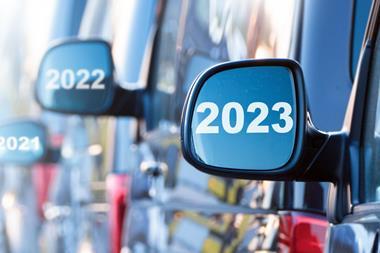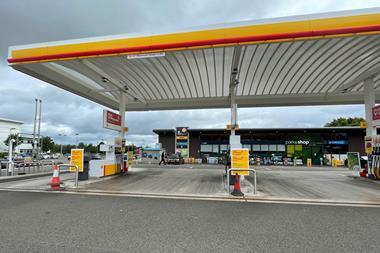Shoppers continued to develop a healthy appetite for food-to-go on forecourts last year, helping to boost sales in the sector and cut retailers’ reliance on tobacco sales.
That’s according to the Evolution of Convenience Retailing report, published by the Institute of Grocery Distribution (IGD), which found that food-to-go was the fastest-growing category in forecourt shops and, as such, was becoming increasingly important to operators’ sales.
The report’s author, IGD senior business analyst Stewart Samuel, said: "The fast food/food-to-go offer accounts for 2.3% of sales in the forecourt shop sector, compared to 1.2% of sales in the total convenience store sector. And it’s growing. This includes hot drinks - more than half of all forecourt stores now provide at least one hot beverage dispenser. The food-to-go offering in forecourts has really moved on in the past three to four years.
"What’s more, many retailers now view the development of the food-to-go category as a key priority in order to reduce their dependency on tobacco sales."
Almost half of food- or drink-to-go consumers - 49% - told IGD that they would choose a c-store to make their purchase, significantly ahead of other outlets.
However, when looking specifically at just hot food-to-go, only 12% of consumers said they preferred to make that purchase at a local c-store - showing there was plenty of room to grow sales in that area.
The report, which was published last month, also found that general sales through forecourt-based convenience stores increased by 5.1% to £4.1bn in the year to December 31, 2008.
According to IGD researchers, this was driven by a slight rise in the total number of forecourt stores in the UK to 8,641. And while this represented just a 0.1% year-on-year increase, it was notable in that it was the first rise in forecourt store numbers since 2002.
Samuel said: "The growth in store numbers is very positive, although it’s a bit too early to say if it’s the end of the recession.
"But even as you drive around you can see new forecourts being built and developed. And more importantly, some sites which had been decommissioned and mothballed are now coming back onto the market. I think it’s all very positive."
== Symbols of growth ==
Forecourt Trader publisher William Reed Business Media, which provided research on independents and forecourt store numbers for the report, revealed symbol group operators in particular had been targeting the forecourt sector. There was a decline in the number of non-affiliated independents, driven partly by migration to symbol groups - the number of symbol group stores on forecourts increased in 2008 by 8.1%.
Samuel said that this was the continuation of an ongoing trend, adding: "The symbol groups offer strong promotional packages, private label ranges and marketing, and the move to symbol groups is definitely one of the elements that is making the forecourt sector stronger.
"The symbol group companies also seem to be taking into account factors such as whether the site is transitional or neighbourhood, and tailoring their package to suit that."
In other forecourt-specific data, tobacco continued to be highlighted as an important element of the forecourt store offer, accounting for almost a third of all sales.
Samuel said this was "significantly higher" than in any other sector of the convenience market, and was also ahead of the sample average which stood at 19.8%. However, retailers have been aware for some time of the potential dark clouds which are looming over tobacco sales through upcoming legislation (don’t miss our in-depth update on the tobacco category in our feature on page 45 of this issue).
Non-food products also remained important and accounted for 12.5% of sales in forecourt shops - the report stated that this mainly related to car care, oils, lubricants and maps.
However, the report found that last year there seemed to be a renewed focus by a number of operators on offering a wider range of non-food products such as SatNav systems, DVDs and gift ranges based around various seasonal occasions like Mother’s Day and Valentine’s Day.
Overall, Samuel said the report suggested a very positive outlook for the forecourt sector in general, especially considering the current tough economic climate.
He added: "We found that sales overall, and on food and grocery in particular, have proven to be very resilient. During a recession it is very important to have a strong value message.
"And I think we’ve seen the convenience sector and forecourt sector respond to the challenge of the recession very well."
----
=== Getting fresh ===
The IGD report revealed that the general convenience store market increased in value to £29.1bn in 2008 - which represents a respectable 6.1% increase over the previous year.
Fresh food continued to be a big growth area for the convenience sector, accounting for 30% of total sales.
IGD’s senior business analyst Stewart Samuel explained: "Retailers are developing sites in line with shopper trends. They’ve seen companies like Marks & Spencer, in particular, moving into the fresh food sector on forecourts, and now retailers have access to a pretty wide range of fresh food with deliveries six or even seven days a week.
"The symbol groups have also been increasing capability. So we’re seeing that there’s the availability aspect along with better quality food and more advice being given to retailers.
"There are obviously some challenges for the forecourt sector because its stores are generally about half the size that they are in the convenience store sector. Retailers need to have a full chilled and fresh offer but they often have to deal with limited space.
"Scratch cooking is still a growth area and there is less dependency on areas such as ready meals. People are spending more time at home and if you look at the major multiples they have responded well to this with their ’meal deal’ options."
Finally, the IGD report noted the growth of the convenience sector in general continued to outpace the growth of the UK grocery market overall, with forecasts that the convenience market could be worth as much as £39.7bn by 2014.
----
=== Average Sales Contribution (%): Forecourt Convenience Stores 2005-2008 ===
Fast food/food-to-go
2008: 2.3%
2007: 2.0%
2006: 1.4%
2005: 1.1%
Source: IGD





























No comments yet